Italian and Japanese heavy artillery of World War I
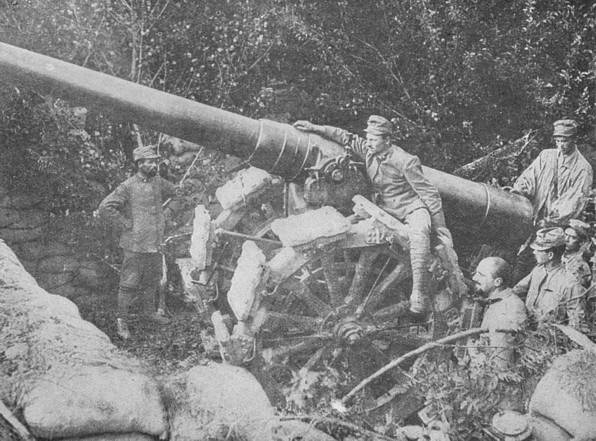
Photo, as if directly from the Boer War! Then such tools were used there. However, the Kremlin was also shelled from similar guns in July 1918 and they were even used near Moscow in 1941 ...
With love for them I burn with heaven.
I love pasta
And what do you want to do with me!
Y. Kim
Italy
Weapon World War I And it happened that there was a Terni plant in Italy, which was managed by ... Sir William Armstrong, and this plant was created to supply the Italian fleet naval guns. And he really supplied these guns, but at the turn of the century he switched to the production of artillery pieces for the army.
Cannone Da 149/35A
One of the first such developments was Cannone Da 149/35 A (149 - caliber in millimeters, 35 - barrel length in calibers).
149/35 A can hardly be called a modern design: the gun had no recoil suppression. That is, it was just an old-fashioned gun mount that rolled back and hit the wheels on two recoil brake ramps - wedges located behind them. The gun rolled along them when fired “uphill”, and then rolled back when the recoil force ceased. Because of this, the gun had to be aimed again after each shot.
In addition, it was quite difficult to prepare it for opening fire: it required about two hours of work, since optimal results would be obtained when the gun was mounted on a special wooden platform.
But, in addition to the low rate of fire (at best, one shot per minute, often lower), the gun also had its advantages: a high initial speed (651 m / s) provided a good firing range (16 m) and grenades weighing 500 kg ( OF) and 42 kg (shrapnel). That is, for such a relatively small caliber - after all, not 43,4 and not 155, it fired shells of sufficient power. The weight of the gun was about 152 tons, but it was still quite versatile and could be used both as siege artillery and as heavy field artillery.
The Da 149/35 A gun appeared in 1905 and immediately became widely used. The battery consisted of 4 guns, 4 tractors and 10 trucks with standard ammunition of 70 grenades per gun. The gun itself could be towed at a maximum speed of 6–8 km/h. That is, it cannot be said that this weapon had high performance. Nevertheless, this gun was effectively used by the Italian army at all stages of the First World War and, despite its age, remained in service in the middle of the war, and even served until the Second World War.
The Da 149/35 A was last seen in action during the Allied invasion of Sicily, although by then it was completely obsolete. This old cannon had such an interesting fate - the most "small-caliber" among similar guns of the allies in the Entente.
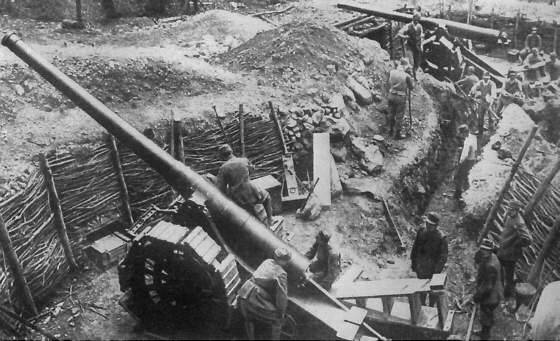
The position of Cannone Da 149/35 A. Triangular ramps are clearly visible - rollback brakes
Mortaio da 210/8DS
The Italian Mortaio da 210/8 DS (210 mm mortar) was developed in the last years of the 210th century and was intended for use against fortifications and other similar well-defended targets. To bring the Mortaio da 8/XNUMX into action, a lot of effort was required, since the gun had to be disassembled when moving even a short distance, and all parts loaded onto trailers or conveyors.
When assembling the gun on a carefully leveled site, it was necessary to first install a heavy wooden platform (not included in the transported weight of the gun), after which it could be assembled.
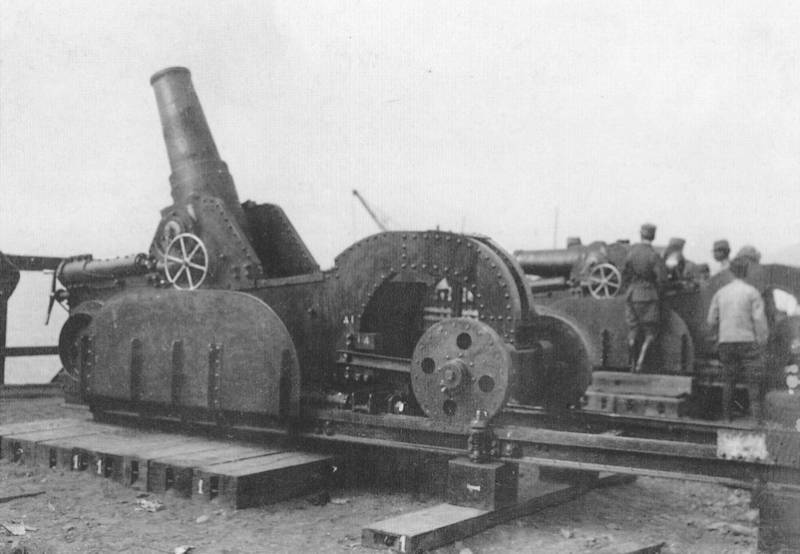
Was it necessary to come up with this?
This work usually took 6 to 8 hours. Although, if we compare it with a 149-mm cannon, it turns out that its weight in the stowed position was 7,8 tons, and even less in the set for firing - 5,79 tons. A successful technical solution allowed her to rotate 360 °. So the immobility of this gun was not such a big problem for the Italians, since the front line along the border with Austria-Hungary was pretty static most of the time.
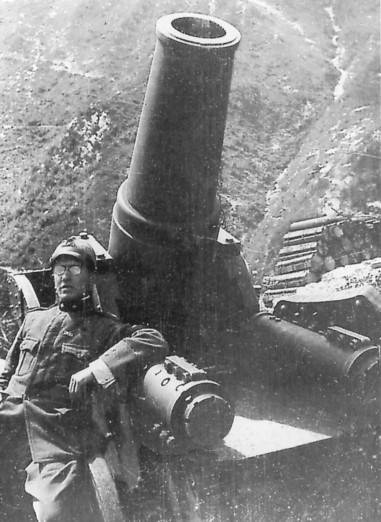
Zevrorotaya, isn't it?
The overall length of the barrel was only 9,7 calibers (2 mm), and the length of the bore was only 048 calibers. Elevation angles from -7,1° to +15°. The gun could fire a 70-kilogram projectile with an initial velocity of 101,5 m/s to a maximum range of only 340 m. At the same time, the effect of its projectiles was enhanced by the almost vertical trajectory of the projectile. The rate of fire was low, typically 8 shot every 450–1 minutes.
The gun used a variant of the so-called De Stefano carriage, hence the letters DS in the designation. It was designed in such a way that most of the recoil was absorbed by the cradle on which the barrel rested. When fired, the cradle slid backwards over short, sloping ramps. At the same time, the entire upper carriage also rolled away on four wheels along two inclined rails. Then he returned back to his original position under the influence of gravity and a return spring.
Mortaio da 210/8 DS was used in batteries consisting of 4 guns, 4 trucks and 1 ammunition vehicle. The battery in motion stretched for 420 m and moved at a maximum speed of 6–8 km/h. This weapon was also used during the Second World War, although it has long been and clearly outdated.
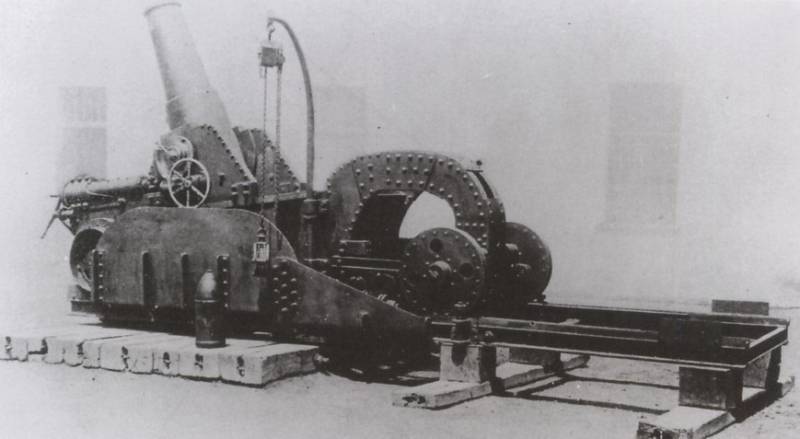
Wooden beams, projectile and crane ...
Japan
As for Japan, here we must start with the fact that instead of 150–155 mm they used 10 cm (105 mm) German howitzer guns - typical guns of the early twentieth century.
Interestingly, during the First World War, Japan supplied the same guns to Russia, but ... with a channel drilled to 107 mm. And that's how these Japanese guns appeared with us.
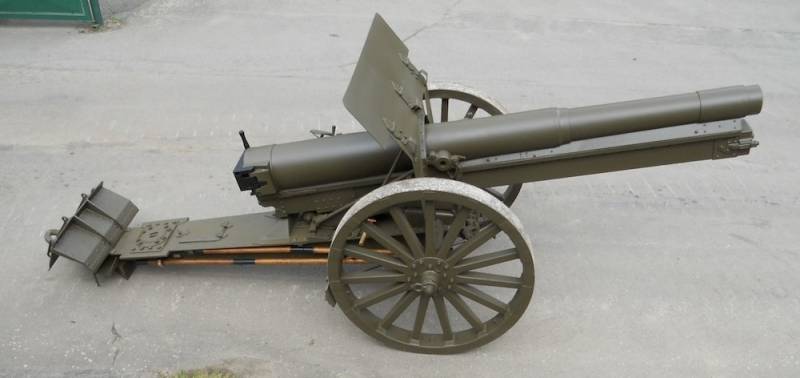
Japanese 105 mm Krupp gun. Photo landships.info
Well, the main large-caliber guns of the Japanese were 240-mm and 280-mm mortar howitzers.
Type 45
The 24 cm Type 45 was adopted in 1912 as a replacement for the heavy Krupp 28 cm howitzers which were used with great success during the siege of Port Arthur in 1905 during the Russo-Japanese War.
The 24 cm howitzer was the first large artillery piece of purely Japanese design, although some of the ideas of European designers seem to have influenced its design.
Like many large-caliber guns, the trunnions of the barrel were attached to a cradle, inside of which the barrel could slide. Two recoil and knurled brake cylinders were attached to the cradle and barrel. The howitzer was loaded at an angle of 0 °, and the projectile was delivered to it on a small cart with wheels. The howitzer had a small crane to lift the shells. She also had two gun shields at once - a large shield with a cut-out for the barrel, attached to a rotating platform, and a smaller shield attached to the barrel, which rose with it, presumably to protect the crews of the gun from muzzle flash. The breech, common in Japanese practice, had a screw breech. The ammunition was separate, a brass sleeve was used for obturation.
The howitzer was very heavy, about 37 tons installed, so great efforts were made to move and install at least one such colossus. This required, presumably, 10 horse-drawn carts.
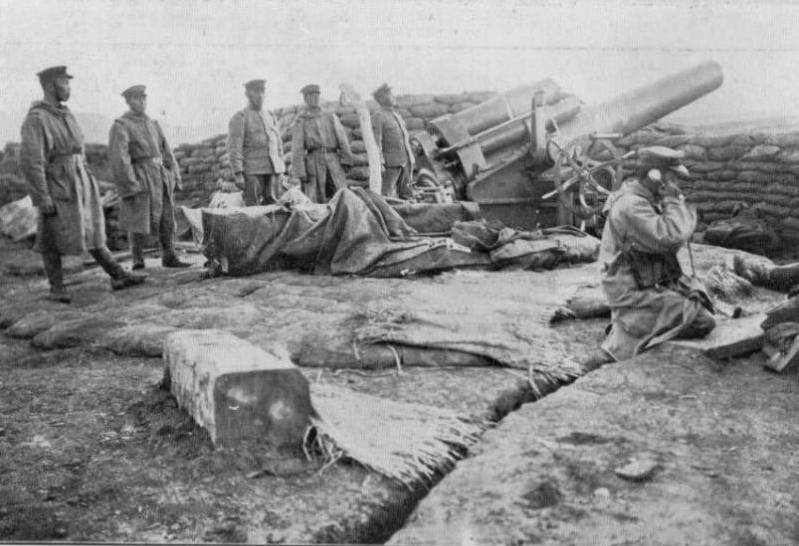
240 mm Japanese howitzer-mortar Type 45 in position
Unlike other siege howitzers, the Type 45 could not be used as heavy field artillery due to its weight and very slow deployment.
In total, about 80 of these howitzers were made, but their use in the First World War was limited to the siege of Qingdao in 1914. Despite the fact that Japan fought in China in the 1930s, it did not require siege artillery, and Type 45 howitzers remained in storage or as coastal defense guns.
A small number of Type 45 howitzers were used early in the war to lay sieges to defenses in Hong Kong, Bataan, and Corregidor. There are suggestions that Type 45 howitzers were also used against the Red Army in Manchuria in 1945.
TTX
Caliber: 24 cm.
Barrel length 3,89 m L / 16,2.
Gun weight (installed): 33 kg.
Installation time: 1-2 days.
Elevation angles: -2° to +65°.
Horizontal guidance: 360°.
Projectile weight: 200 kg.
Initial speed: 360 m/s.
Firing range: 10 400 m.
20 cm and 28 cm howitzers
11 copies of the 20-cm howitzer were also made.
Along with the 24 cm howitzer, they participated in the siege of Qingdao in 1914. The 20 cm howitzers were then withdrawn from service and sold to the Russian government in 1915.
Here our military discovered that not a single Russian gun used this caliber, but, ultimately, Russian-made 203-mm shells were turned to 197,5 mm caliber. Russian modified shells were heavier (115 kg) compared to Japanese shells and, as a result, had a slightly shorter range.
The final fate of the 20 cm howitzers is unknown, and apparently none of them survived.
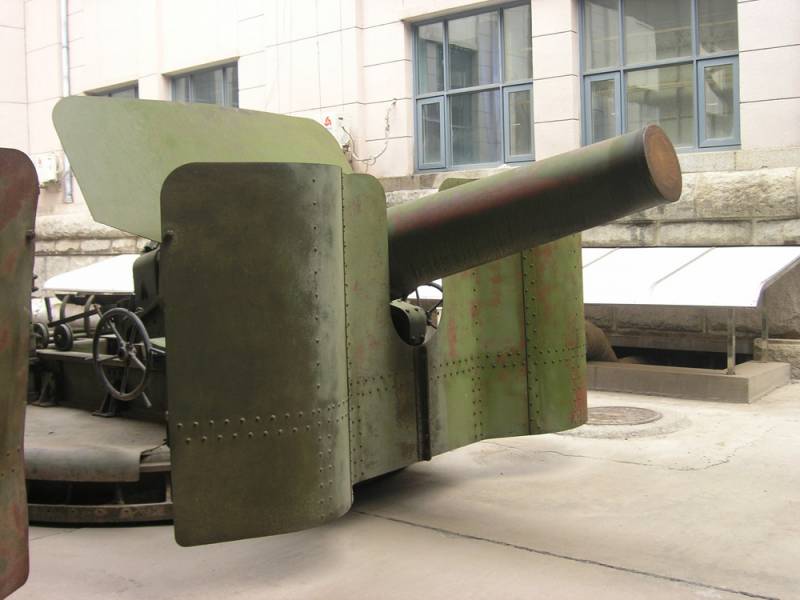
Type 45. Photo by landships.info
When Japan went to war with Russia in 1904, few expected the Japanese to last long in combat, let alone achieve victory. Nevertheless, the very next year the war ended in defeat for Russia: two of its fleets were destroyed, and the army was defeated.
There are many reasons for this, and one of them is that the Japanese did not pay attention to their losses! But they also proved to be innovators in the use of land-based heavy artillery against ships.
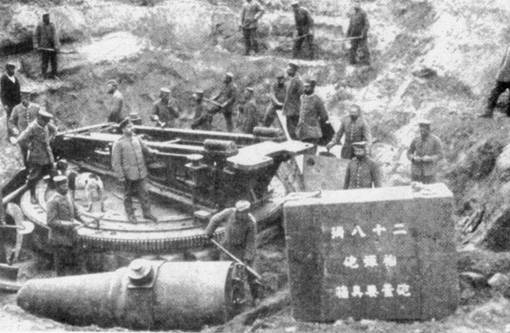
Preparation of the base for a 280-mm howitzer-mortar
The Japanese laid siege to Port Arthur in early May 1904. And already in June, 18 28 cm coastal defense howitzers were dismantled and loaded onto a ship that was supposed to deliver them to the besieging army. Unfortunately for the Japanese, one of the few Russian successes in that war resulted in the ship being sunk, taking its precious cargo of artillery and hundreds of soldiers to the bottom of the sea.
Only in October, the Japanese managed to deliver another 18 howitzers to the battlefield. After capturing a tactically important height (High Mountain) near Port Arthur, during which the Japanese suffered simply shocking losses, they were finally able to shell the port and sink the remnants of the Russian Pacific Fleet.
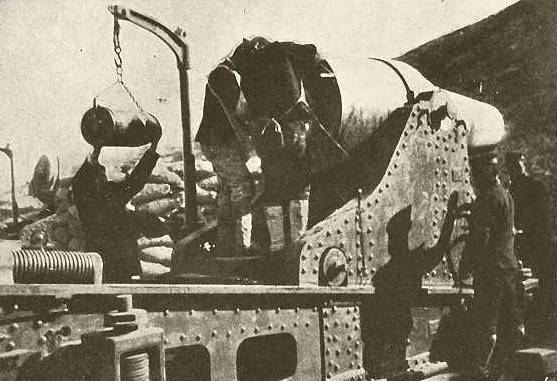
Loading a 280 mm projectile (smoke powder charge 9,5 kg)
Previously, it was believed that these howitzers were manufactured by the Krupp company, although they had an atypical piston valve. But later it turned out that they were made in Japan according to the British project, which was originally developed for the Italians!
It all started with the fact that in April 1884, the Japanese hired the Italian major Pompeio Grillo to teach them how to make weapons. And then, at the Osaka Arsenal in June of the same year, they began pilot production of these howitzers on the basis of a license purchased from ... the British.
That is why the coastal defenses of both Japan and Italy used very similar guns of the same caliber!
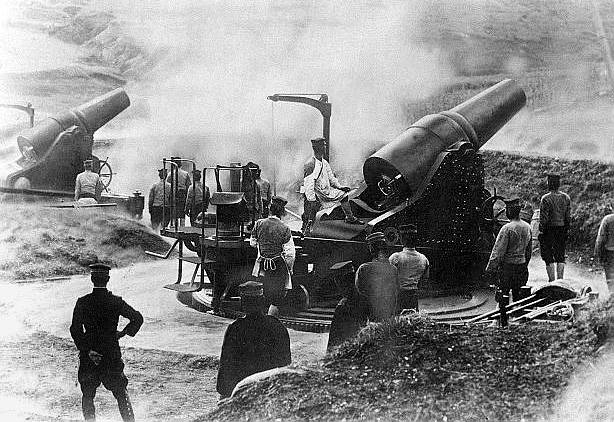
A battery of 280mm howitzers is firing!
It should be noted that all these guns were mounted on turntables, providing 360-degree guidance. At the time, it was believed that their long-range fire and 217-kilogram shells would be deadly against the thin deck armor of enemy battleships that would have to come close to shore.
In any case, thanks to the colossal and hard work of the Japanese, the world learned that such artillery can be used in many ways, although in Europe few people noticed this, except for the Germans, Austrians and Hungarians.
The lesson of Japan stimulated their experiments in heavy field artillery, culminating in the infamous Skoda 30,5 cm mortars and the 42 cm Big Berts.
Information